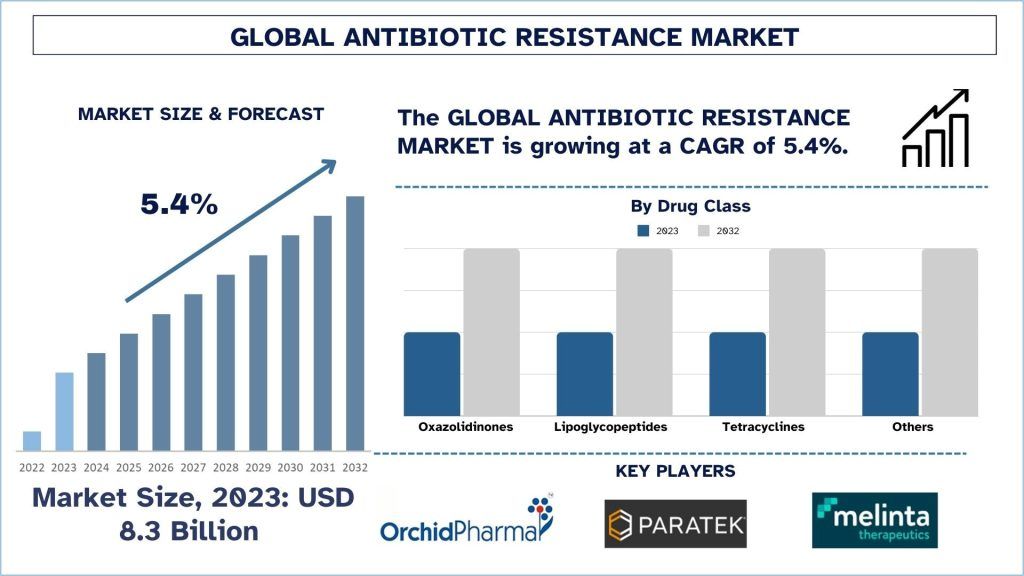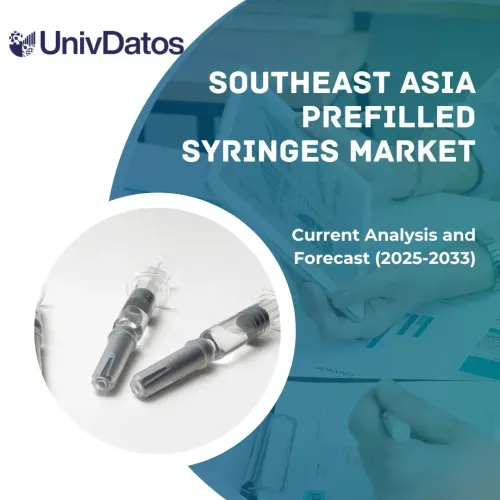- Home
- About Us
- Industry
- Services
- Reading
- Contact Us
Antibiotic Resistance Market: Current Analysis and Forecast (2024-2032)
Emphasis on Disease Type (Urinary Tract Infections, Intra-Abdominal Infections, Blood Stream Infections, Clostridium Difficile Infections, And Others); Pathogen Type (Acinetobacter baumannii, Pseudomonas aeruginosa, Staphylococcus aureus, Streptococcus pneumoniae, and Others); Drug Class (Oxazolidinones, Lipoglycopeptides, Tetracyclines, and Others); and Region/Country
Antibiotic Resistance Market Size & Forecast
The antibiotic resistance market was valued at approximately ~USD 8.3 billion in 2023 and is expected to grow at a strong CAGR of around 5.4% during the forecast period (2024-2032) owing to the increasing cases of antibiotic-resistant infections and increasing investment in antibiotic research & development activities globally.
Antibiotic Resistance Market Analysis
Antibiotic resistance market (AMR) can be treated as an emerging market since it is associated with a new threat to the world’s health – antimicrobial resistance. This is even growing as many of the modern antibiotics cannot fulfill this promise because multi-drug-resistant organisms have developed ways in which they can overcome the effects of these drugs. The main catalysts for the market are the increasing rates of infections, including those acquired in hospitals, and improved awareness of healthcare workers and the population about the effects of AMR. National authorities and institutions invest in the early stages of research and development, the progress of diagnostic methods, vaccines, and management strategies.
Recent Developments in the Market:
- In August 2023, the Global Antibiotic Research and Development Partnership (GARDP) launched an observational study in India that will shed light on the management of antibiotic-resistant infections in hospitals.
Antibiotic Resistance Market Trends
This section discusses the key market trends that are influencing the various segments of the antibiotic resistance market, as identified by our team of research experts.
The Blood Stream Infections Segment Transforming Industry
The constant increase in the antibiotic resistance bloodstream infection (BSI) segment is expected due to the constantly increasing number of multidrug-resistant organisms, including Gram-negative bacteria such as Klebsiella pneumoniae and Escherichia coli. The continuous report of higher levels of resistance to traditional antibiotics among such pathogens, there is a growing need for treatment. Moreover, bloodstream infection is life-threatening and complicated and results in high mortality among hospitalized patients and immunocompromised persons. This has prompted pharmaceutical firms to try and come up with new antibiotics, with different actions and a combination of therapies that work well against resistant strains of bacteria.

Asia-Pacific is expected to dominate the market during the forecast period
This market has been growing in the Asia-Pacific (APAC) region because of a high incidence of infections, the emergence of more antibiotics-resistant pathogens, and awareness of the bio-threat of AMR. The increase in healthcare-associated infections and community-acquired infections cut across regions witnessing increased rates of urbanization, changing population lifestyles, and poor infection control measures. Global and country authorities are focusing on the implementation of national action plans for dealing with antibiotic resistance that have elevated funding for antibiotic innovation and new treatment methods. The regions are also experiencing a rising stream of investments in rapid diagnostic technologies as fundamental as identification of resistant strains and accurate treatment approaches.
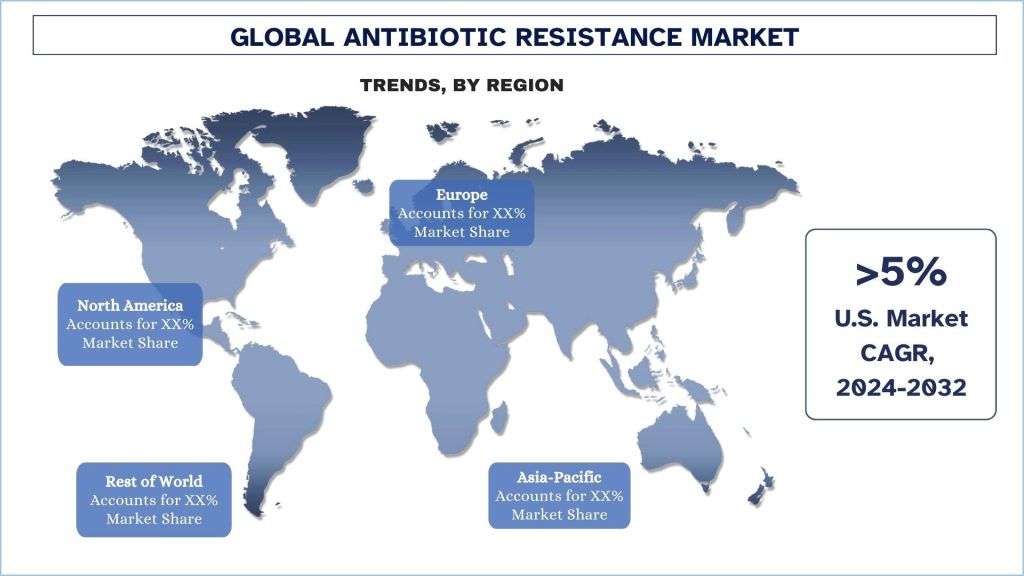
Antibiotic Resistance Industry Overview
The antibiotic resistance market is competitive, with several global and international market players. The key players are adopting different growth strategies to enhance their market presence, such as partnerships, agreements, collaborations, geographical expansions, and mergers and acquisitions. Some of the major players operating in the market are Pfizer Inc.; Orchid Chemicals & Pharmaceuticals Limited; Melinta Therapeutics, LLC; Innoviva Specialty Therapeutics; Basilea Pharmaceutica Ltd; Wockhardt Limited; Paratek Pharmaceuticals, Inc.; Seres Therapeutics, Inc.; Cipla; Merck & Co. Inc.
Antibiotic Resistance Market News
- In March 2024, Pfizer announced that the Committee for Medicinal Products for Human Use (CHMP) of the European Medicines Agency (EMA) adopted a positive opinion, recommending the granting of a marketing authorization for EMBLAVEO (aztreonam-avibactam) in the treatment of adult patients with complicated intra-abdominal infections (cIAI), hospital-acquired pneumonia (HAP) including ventilator-associated pneumonia (VAP), and complicated urinary tract infections (cUTI), including pyelonephritis.
- In December 2023, Orchid Pharma announced a merger with Dhanuka Labs, the promoter of the company, in a significant move towards achieving consolidation and fueling the next level of growth.
Antibiotic Resistance Market Report Coverage
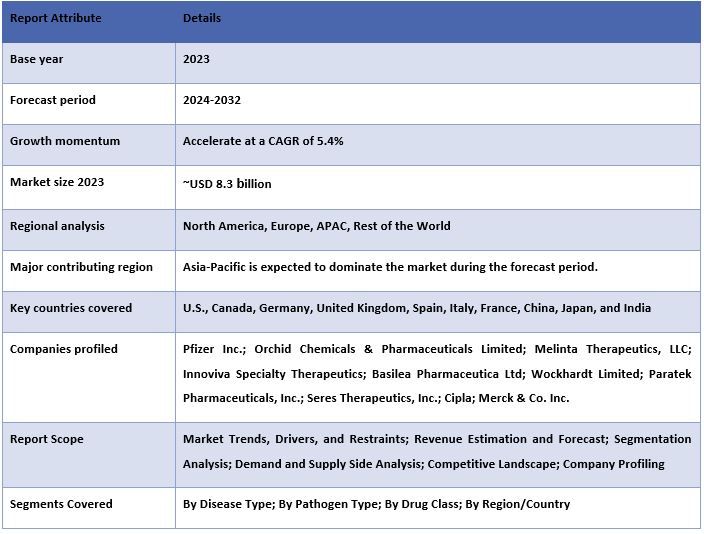
Reasons to buy this report:
- The study includes market sizing and forecasting analysis validated by authenticated key industry experts.
- The report presents a quick review of overall industry performance at one glance.
- The report covers an in-depth analysis of prominent industry peers with a primary focus on key business financials, product portfolios, expansion strategies, and recent developments.
- Detailed examination of drivers, restraints, key trends, and opportunities prevailing in the industry.
- The study comprehensively covers the market across different segments.
- Deep dive regional level analysis of the industry.
Customization Options:
The global antibiotic resistance market can further be customized as per the requirement or any other market segment. Besides this, UMI understands that you may have your own business needs, hence feel free to connect with us to get a report that completely suits your requirements.
Table of Content
Research Methodology for the Antibiotic Resistance Market Analysis (2024-2032)
Analyzing the historical market, estimating the current market, and forecasting the future market of the global antibiotic resistance market were the three major steps undertaken to create and analyze the adoption of antibiotic resistance in major regions globally. Exhaustive secondary research was conducted to collect the historical market numbers and estimate the current market size. Secondly, to validate these insights, numerous findings and assumptions were taken into consideration. Moreover, exhaustive primary interviews were also conducted, with industry experts across the value chain of the global antibiotic resistance market. Post assumption and validation of market numbers through primary interviews, we employed a top-down/bottom-up approach to forecasting the complete market size. Thereafter, market breakdown and data triangulation methods were adopted to estimate and analyze the market size of segments and sub-segments of the industry pertains to. Detailed methodology is explained below:
Analysis of Historical Market Size
Step 1: In-Depth Study of Secondary Sources:
A detailed secondary study was conducted to obtain the historical market size of the antibiotic resistance market through company internal sources such as annual reports & financial statements, performance presentations, press releases, etc., and external sources including journals, news & articles, government publications, competitor publications, sector reports, third-party database, and other credible publications.
Step 2: Market Segmentation:
After obtaining the historical market size of the antibiotic resistance market, we conducted a detailed secondary analysis to gather historical market insights and share for different segments & sub-segments for major regions. Major segments are included in the report, such as disease type, pathogen type, drug class, and regions. Further country-level analyses were conducted to evaluate the overall adoption of testing models in that region.
Step 3: Factor Analysis:
After acquiring the historical market size of different segments and sub-segments, we conducted a detailed factor analysis to estimate the current market size of the antibiotic resistance market. Further, we conducted factor analysis using dependent and independent variables such as disease type, pathogen type, drug class, and regions of the antibiotic resistance market. A thorough analysis was conducted for demand and supply-side scenarios considering top partnerships, mergers and acquisitions, business expansion, and product launches in the antibiotic resistance market sector across the globe.
Current Market Size Estimate & Forecast
Current Market Sizing: Based on actionable insights from the above 3 steps, we arrived at the current market size, key players in the global antibiotic resistance market, and market shares of the segments. All the required percentage shares split and market breakdowns were determined using the above-mentioned secondary approach and were verified through primary interviews.
Estimation & Forecasting: For market estimation and forecast, weights were assigned to different factors including drivers & trends, restraints, and opportunities available for the stakeholders. After analyzing these factors, relevant forecasting techniques i.e., the top-down/bottom-up approach were applied to arrive at the market forecast for 2032 for different segments and sub-segments across the major markets globally. The research methodology adopted to estimate the market size encompasses:
- The industry’s market size, in terms of revenue (USD) and the adoption rate of the antibiotic resistance market across the major markets domestically.
- All percentage shares, splits, and breakdowns of market segments and sub-segments.
- Key players in the global antibiotic resistance market in terms of products offered. Also, the growth strategies adopted by these players to compete in the fast-growing market.
Market Size and Share Validation
Primary Research: In-depth interviews were conducted with the Key Opinion Leaders (KOLs) including Top Level Executives (CXO/VPs, Sales Head, Marketing Head, Operational Head, Regional Head, Country Head, etc.) across major regions. Primary research findings were then summarized, and statistical analysis was performed to prove the stated hypothesis. Inputs from primary research were conso0lidated with secondary findings, hence turning information into actionable insights.
Split of Primary Participants in Different Regions
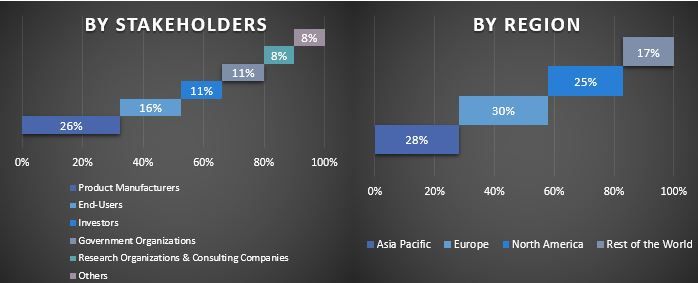
Market Engineering
The data triangulation technique was employed to complete the overall market estimation and to arrive at precise statistical numbers for each segment and sub-segment of the global antibiotic resistance market. Data was split into several segments and sub-segments after studying various parameters and trends in the areas of disease type, pathogen type, drug class, and regions in the global antibiotic resistance market.
The main objective of the Global Antibiotic Resistance Market Study
The current & future market trends of the global antibiotic resistance market were pinpointed in the study. Investors can gain strategic insights to base their discretion for investments on the qualitative and quantitative analysis performed in the study. Current and future market trends determined the overall attractiveness of the market at a regional level, providing a platform for the industrial participant to exploit the untapped market to benefit from a first-mover advantage. Other quantitative goals of the studies include:
- Analyze the current and forecast market size of the antibiotic resistance market in terms of value (USD). Also, analyze the current and forecast market size of different segments and sub-segments.
- Segments in the study include areas of the disease type, pathogen type, drug class, and regions.
- Define and analyze the regulatory framework for the antibiotic resistance
- Analyze the value chain involved with the presence of various intermediaries, along with analyzing customer and competitor behaviors of the industry.
- Analyze the current and forecast market size of the antibiotic resistance market for the major region.
- Major countries of regions studied in the report include Asia Pacific, Europe, North America, and the Rest of the World
- Company profiles of the antibiotic resistance market and the growth strategies adopted by the market players to sustain in the fast-growing market.
- Deep dive regional level analysis of the industry.
Frequently Asked Questions FAQs
Q1: What is the antibiotic resistance market's current market size and growth potential?
Q2: What are the driving factors for the growth of the antibiotic resistance market?
Q3: Which segment has the largest share of the antibiotic resistance market by disease type?
Q4: What are the emerging technologies and trends in the antibiotic resistance market?
Q5: Which region will dominate the antibiotic resistance market?
Related Reports
Customers who bought this item also bought

